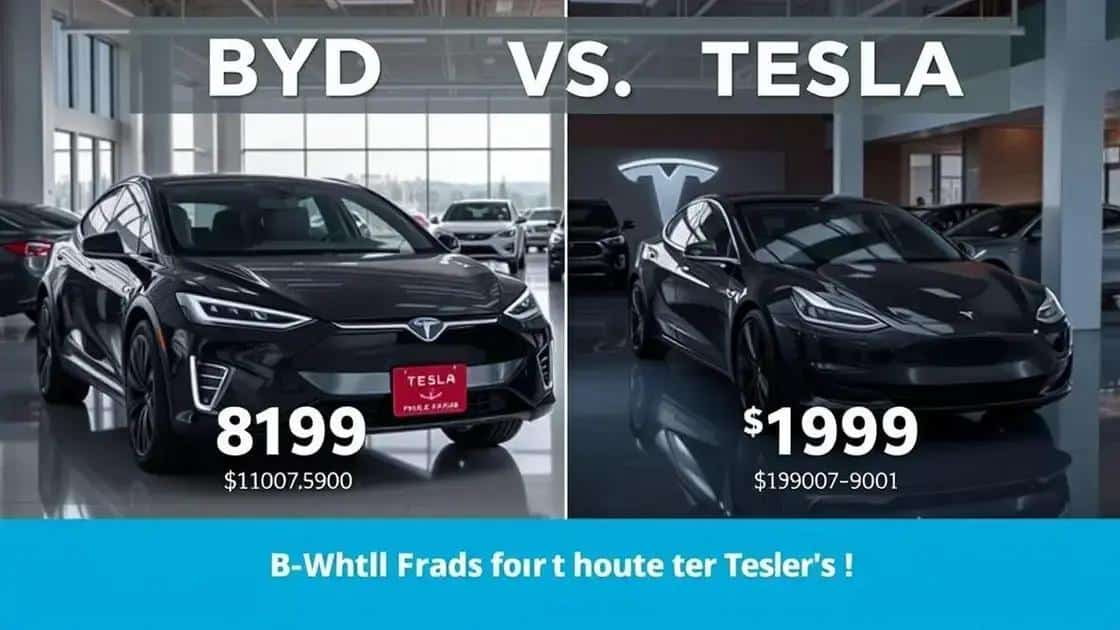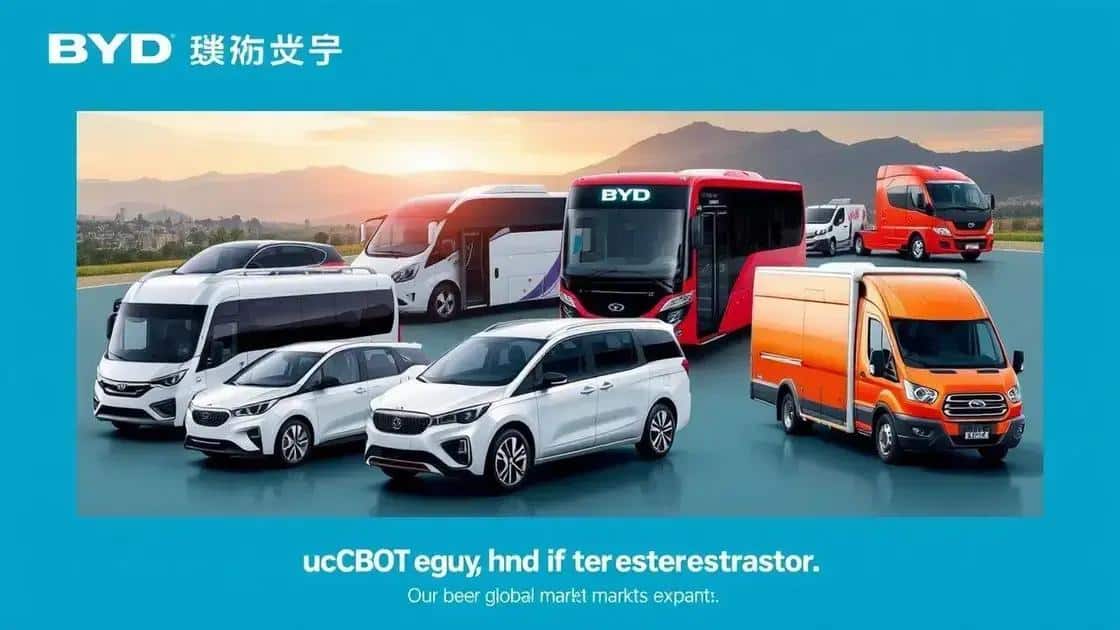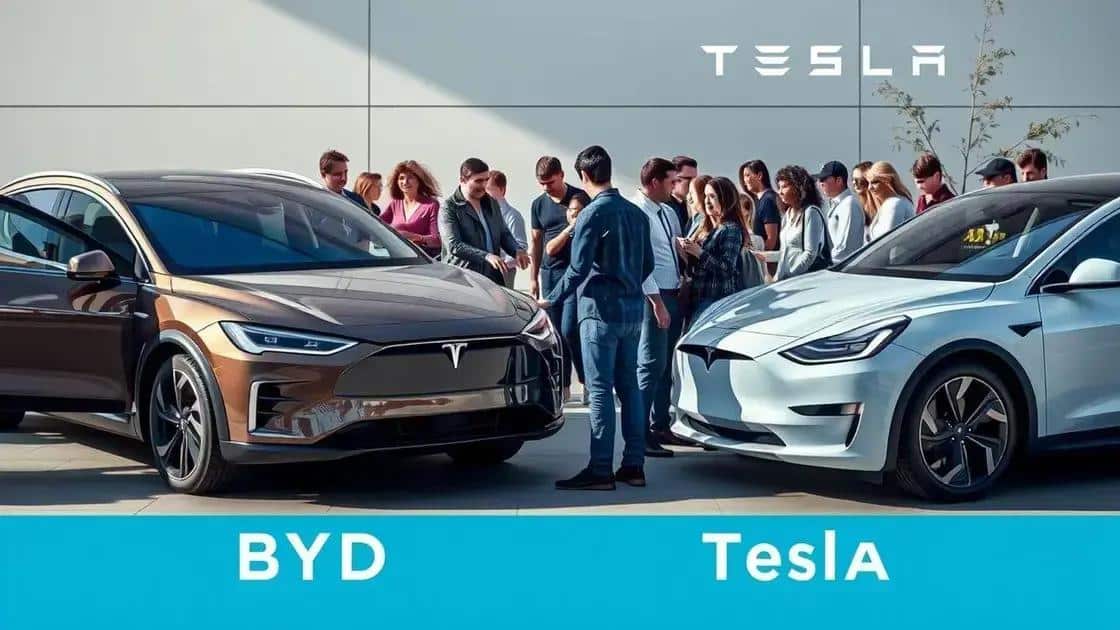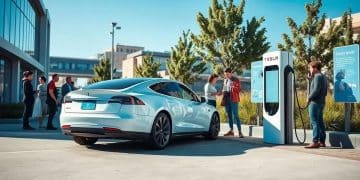All the ways BYD is leaving Tesla in the dust
Anúncios
All the ways BYD is leaving Tesla in the dust include its focus on affordability, diverse vehicle offerings, strong market expansion, and sustainable manufacturing practices, appealing to a broader consumer base compared to Tesla’s premium and tech-focused image.
All the ways BYD is leaving Tesla in the dust truly showcases how this Chinese automaker is shaking up the electric vehicle industry. With an impressive combination of innovation and affordability, BYD is capturing consumer attention and reshaping the market dynamics. Curious about what this means for the future of electric vehicles?
A look at BYD’s innovative technology
A look at BYD’s innovative technology reveals the driving force behind its rapid growth in the electric vehicle market. This Chinese company has pioneered advancements that set it apart from competitors like Tesla.
One major area of innovation is in battery technology. BYD has developed the Blade Battery, which emphasizes safety and efficiency. This battery design not only reduces the risk of fire but also increases energy density, allowing for longer driving ranges.
Battery Technology Advantages
- 🛡️ Enhanced safety: Blade Batteries are more resistant to punctures
- 🔋 Longer lifespan: These batteries can endure more charging cycles
- ⚡ Faster charging: Innovations allow for quicker recharging times
Another key innovation is BYD’s focus on vertical integration. By producing many components in-house, they maintain control over quality and costs. This strategy enables them to adapt quickly to market demands and implement changes rapidly.
Additionally, BYD is also leading the way in integrating renewable energy solutions. The company is pairing its electric vehicles with solar power solutions, creating a sustainable ecosystem that benefits not only car owners but the environment as well.
Integration of Renewable Energy
- Solar charging stations: Offer convenient charging options.
- Green energy partnerships: Collaborate with energy companies to enhance sustainability.
- Consumer incentives: Encourage the adoption of electric vehicles through green initiatives.
By focusing on innovation in technology and integrating sustainability into their processes, BYD is not only succeeding in the electric vehicle market but also setting new benchmarks for the industry. Their approach to technology continues to reshape how consumers perceive electric vehicles and their potential impact on daily life.
Comparing pricing strategies of BYD and Tesla

Comparing the pricing strategies of BYD and Tesla reveals significant differences that affect customer choices. Both companies aim to attract consumers in the growing electric vehicle market, yet their approaches vary widely.
BYD often takes a more aggressive pricing strategy, focusing on affordability without sacrificing quality. By keeping prices lower, they can target a broader audience. This approach attracts buyers who might find Tesla’s prices intimidating. For instance, BYD’s entry-level models are significantly cheaper than Tesla’s offerings, making them accessible to more consumers.
BYD’s Affordable Approach
- Lower starting prices: Aimed at budget-conscious customers.
- Incentives: Often offers discounts or promotions to encourage purchases.
- Value for money: Focuses on providing features that satisfy customer needs without extra costs.
Conversely, Tesla positions itself as a premium brand, with a pricing strategy that reflects its innovative technology and high performance. Customers often associate Tesla with luxury and status, which allows the company to maintain higher profit margins. Their vehicles tend to be more expensive, but buyers are willing to pay for the brand name and advanced features.
Additionally, Tesla’s dynamic pricing model can lead to sudden changes in vehicle costs based on demand and market conditions. For example, if a model gains popularity, Tesla may increase its price to reflect increased demand.
Tesla’s Premium Market Position
- Brand perception: Strong emphasis on luxury and innovation.
- High demand: Prices are often adjusted based on market interest.
- Exclusive features: Advanced technology justifies higher costs.
Through these contrasting pricing strategies, BYD and Tesla cater to different segments of the market. BYD’s focus on affordability may attract first-time electric vehicle buyers, while Tesla’s premium pricing appeals to those who prioritize brand prestige and cutting-edge technology.
The role of government support for BYD
The role of government support for BYD has been crucial in its rapid rise within the electric vehicle market. Various incentives and policies have helped shape the company’s growth and success, allowing it to compete effectively against major players like Tesla.
Governments in China have implemented numerous programs aimed at boosting electric vehicle sales. These initiatives include substantial subsidies that lower the costs for consumers, making BYD cars more appealing. Thanks to these subsidies, BYD can offer competitive pricing without sacrificing quality or technology in their vehicles.
Types of Government Support
- Financial incentives: Direct subsidies to buyers make EVs more affordable.
- Tax breaks: Reduced taxes for electric vehicle manufacturers.
- Research funding: Support for innovation in battery and vehicle technology.
Additionally, the Chinese government has set ambitious targets for reducing carbon emissions. This commitment creates a favorable environment for companies like BYD, which align with these sustainable goals. The push toward clean energy also leads to investments in infrastructure, such as charging stations, which benefit all electric vehicle manufacturers.
Moreover, geopolitical factors can influence government support. Trade policies and international relations impact how companies like BYD operate within and outside China. Government backing can provide a competitive advantage in markets where other manufacturers face tariffs or regulations. BYD’s strategic partnerships with local governments further bolster its standing and allow for shared investments in innovation and development.
Strategic Partnerships
- 🤝 Joint ventures: Collaborating with local governments for economic benefits
- 🏗️ Infrastructure development: Partnering to enhance charging network availability
- 🧪 Research collaborations: Working with institutions to innovate
Overall, government support not only fuels BYD’s growth but also positions it as a leader in the electric vehicle landscape. The combination of financial incentives and favorable policies has created a robust foundation for BYD to thrive in an increasingly competitive market.
How BYD is expanding its market reach

How BYD is expanding its market reach is a dynamic process that involves strategic initiatives and innovative practices. As a major player in the electric vehicle sector, BYD is making significant moves to broaden its presence both domestically and internationally.
One effective strategy is their focus on international markets. BYD is actively entering new countries, particularly in Europe and Southeast Asia. By collaborating with local companies, they are establishing a foothold that allows them to adapt to local preferences and regulations. This global expansion enhances their visibility and competitiveness in the electric vehicle landscape.
International Expansion Strategies
- Partnerships: Forming alliances with local firms to understand market needs.
- Manufacturing plants: Setting up production facilities in target countries to reduce costs.
- Local marketing: Tailoring advertising campaigns to resonate with local consumers.
In addition to geographic expansion, BYD is diversifying its product offerings. This includes not only electric cars but also buses and trucks. By providing a range of vehicles, BYD can meet different customer needs and tap into various segments of the market. For example, their electric buses are becoming popular in urban areas as cities seek to reduce emissions.
Furthermore, investment in research and development is crucial. BYD is committed to enhancing its technology, particularly in battery performance and charging solutions. By leading in innovation, they can attract tech-savvy consumers who prioritize cutting-edge features.
Product Diversification
- Electric buses: Designed for public transportation, contributing to cleaner cities.
- Commercial vehicles: Expanding into trucks and vans for businesses.
- Smart technologies: Incorporating advanced features in vehicles for enhanced user experience.
BYD’s commitment to sustainability also plays a vital role in their market expansion. As environmental consciousness grows, consumers are more likely to gravitate toward brands that prioritize eco-friendly practices. BYD’s emphasis on clean energy solutions helps strengthen their appeal to environmentally-aware consumers.
Sustainability efforts by BYD versus Tesla
Sustainability efforts by BYD versus Tesla showcase different approaches to eco-friendly practices in the electric vehicle market. Both companies recognize the importance of sustainability, but they implement their strategies in distinct ways.
BYD prioritizes sustainable manufacturing processes. The company has committed to producing vehicles with minimal environmental impact. For instance, BYD utilizes renewable energy in its factories and emphasizes recycling materials used in production. This holistic approach ensures that their carbon footprint remains low from start to finish.
BYD’s Commitment to Sustainability
- Renewable energy sources: Solar and wind energy are used in facilities.
- Recycling initiatives: Reusing materials to reduce waste.
- Green supply chains: Partnering with suppliers who share similar sustainability goals.
In contrast, Tesla focuses on innovation to drive sustainability. The company is renowned for its advancements in battery technology, which aim to create longer-lasting and more efficient batteries. Tesla also promotes a sustainable lifestyle through its products, encouraging customers to adopt renewable energy solutions at home, such as solar panels and Powerwall systems.
This approach not only addresses the vehicles’ carbon footprint but also extends to consumers’ homes, making sustainability a lifestyle choice rather than just a product feature.
Tesla’s Innovative Approach
- 🔋 Battery advancements: Developing longer-lasting and recycling-friendly batteries
- ☀️ Energy solutions: Offering solar products that integrate with electric vehicles
- 🌱 Sustainability partnerships: Collaborating with organizations focused on renewable energy
Both BYD and Tesla contribute positively to the environment, albeit through different methods. BYD emphasizes sustainable manufacturing, while Tesla champions innovation and consumer integration. This diversity in approaches illustrates that there is no single path to sustainability in the electric vehicle industry, highlighting the importance of various strategies in the quest for a greener future.
Consumer perceptions of BYD and Tesla

Consumer perceptions of BYD and Tesla highlight the different ways these electric vehicle brands connect with their customers. Understanding how each brand is viewed can offer valuable insights into their market strategies and product appeal.
BYD, as a relatively newer player on the global electric vehicle scene, is often seen as a budget-friendly option. Many consumers appreciate its affordable pricing and variety of models, from cars to buses. This perception allows BYD to attract first-time electric vehicle buyers who may be hesitant to invest in more expensive options. The emphasis on functionality and value speaks to people looking for dependable transportation without breaking the bank.
Perceptions of BYD
- Affordability: Seen as a cost-effective choice in the electric vehicle market.
- Variety: Offers a wide range of models catering to different needs.
- Growing reputation: Increasing recognition for reliability and performance.
In contrast, Tesla is perceived as a premium and luxury brand. Many consumers associate Tesla with cutting-edge technology and innovation. The impressive features like Autopilot and over-the-air updates contribute to this perception. Tesla also enjoys a strong social media presence, which helps cultivate its image as a leader in electric mobility.
While some consumers view Tesla as aspirational, others express concerns about its pricing and availability. The premium pricing can deter potential buyers who prefer more economical choices. Nevertheless, the loyalty of Tesla’s customer base is strong, as many owners become passionate advocates for the brand.
Perceptions of Tesla
- Innovation: Recognized for advanced technology and performance.
- Luxury branding: Viewed as a status symbol among electric vehicle enthusiasts.
- Customer loyalty: Strong community presence with passionate advocates.
Ultimately, consumer perceptions of BYD and Tesla shape their respective market strategies. BYD’s focus on affordability appeals to budget-conscious buyers, while Tesla’s emphasis on innovation attracts tech-savvy consumers willing to invest in premium products. Each company’s unique approach reflects their commitment to meeting diverse consumer needs in the evolving electric vehicle landscape.
FAQ – Frequently Asked Questions about BYD and Tesla
What makes BYD’s vehicles more affordable than Tesla’s?
BYD focuses on maintaining lower production costs and offers a variety of budget-friendly models, making electric cars accessible to more consumers.
How does Tesla’s technology differ from BYD’s?
Tesla is known for its cutting-edge technology and innovative features, such as Autopilot and high-performance batteries, which contribute to its premium brand image.
What are the main strategies for market expansion for BYD?
BYD is expanding internationally by partnering with local firms, establishing manufacturing plants abroad, and offering a wide range of electric vehicles.
How do consumer perceptions of BYD and Tesla vary?
Consumers generally view BYD as a budget-friendly option while seeing Tesla as a luxury brand known for innovation and high-tech features.






